Recently, I rambled down to Colonel Sam Smith Park in Etobicoke to take a peek at the Least Bittern that was patiently fishing there. I did see the small striped bird skulking through the reeds but the views were obscured by almost a dozen large mammals carrying three-legged cameras. So I wandered off in search of other sights. When I did, I chanced to see two different types of brown furry heads swimming in the duck pond.
What’s this Water Mammal? Is It a Beaver? A Muskrat? Or a Mink?
Muskrats: Sea Serpents with Small Ears
Personally, I’m most familiar with Muskrats. They’re the ones that would float around near my canoe when I was a teen and which are fairly easy to find in any substantial cattail marsh.
When they are lazing around on the water, and in silhouette, they often remind me of a sea serpent. Their rather skinny, scaly tail often loops up out of the water.
Their external ears are so small that they often don’t show at all. Muskrats feed on clams and lily pad roots, among other things. You won’t see one trying to tow a leafy maple branch out underwater, though you may see one towing a small clump of cattails. Personally, I’ve never seen one eating a fish but they can and sometimes do.
According to Hinterland Who’s Who Muskrats have “specially evolved teeth that protrude ahead of the cheeks and lips that can close behind them.” This lets them chew off roots and stems underwater without getting a mouthful of water and/or mud. Handy trick!
Beavers: Huge Muskrats with Noticeable Ears and an Often Hidden Tail
You’d think it would be easy to spot the difference between a Beaver and a Muskrat. After all, Beavers have that huge flat tail that Nature Specials always show them smacking the water with making a noise like a 300-pounder doing a belly flop off the raft.
But surprisingly, the tail is often hard to see on a Beaver. When swimming, it’s often almost hidden from view.
A much easier field mark when swimming by is the ears. The Beaver’s ears, though small and rather cute, are noticeable. The eyes are also less beady looking and more attractive, to me anyway.
The size can be an obvious clue with a mature Beaver. Muskrats usually fairly small, often weighing only a kilogram. Adult beavers can weigh from 16 – 32 kg! The trick is that the young Beavers have to grow through the size of a muskrat and keep going. So any very huge swimming animal (which is not a dog or a deer!) in southern Ontario is likely a Beaver. But any small mammal has to be looked at closely.
While I was visiting the park this week, I stood still on a few limestone blocks near a culvert. To my astonishment, a Beaver suddenly surfaced beside me and breezily swam past up through the culvert and out into Lake Ontario. I’d seen another Beaver earlier that morning but it had been quite a distance away in the Marina. This one was only six feet from me and totally unconcerned.
Mink: A Trail of Silver Bubbles and a Pop Onto Land
I haven’t actually seen a mink swimming along the surface of the water with its head out. I’m sure they must do that but I usually see them on land, usually darting quickly along the shore.
If you did see one in the water, I’d suggest you look at the eyes. Mink, which are smaller than most Muskrats, have a narrow head with eyes set for predation rather than protection. There is a fairly clear photo of one on the Department of Environmental Conservation website. Note, though, that Mink can be much darker coloured than this animal is.
While I was visiting the park, a Mink popped out on a limestone block at the edge of the duck pond just a few yards from me. It was young (by the size) and didn’t really care to look around for predators and threats. Instead, it was focused on getting a snack.
It studied the rather murky water for a few seconds, then dove in.
All that could be seen easily was a trail of silver bubbles. Then, just before it re-surfaced, I could see its long brown body through the water.
It erupted, rather than climbed, out of the water.
Then, a bit to my surprise, it shook look a small dog. Its fur stood up in unbecoming points as it stared back into the water again.
Again it dove neatly into the water. This time it emerged with a fish. Perhaps it saw me, or perhaps it was just wary of the marauding gulls, but it retreated with its catch into a clump of grasses and dogwoods.
Perhaps that was just as well as they sounds of razor-sharp teeth slicing into flesh, cartilage and presumably bone, was rather gruesome!
After a few minutes, it appeared yet again.After scanning the water, poof!
What on earth has it caught?
Whatever it is has antenna!
Phew: It’s just a crayfish.
This time it caught a large crayfish. It took a minute to get it gripped the way it wanted and then it retreated to privacy again to munch.
After that, it either was full or it became wary because it departed, by the sounds I heard, through the cattails towards another part of the pond. (I suspect it didn’t like the ruckus caused by a group of four Mallards. They had come sailing in through the culvert beside me, then noticed me towering above them on the rocks, and had taken off in a frantic flurry of flapping wings and squawking calls. Since that is where the Mink had been trying to fish, I think the commotion it may have discouraged it from returning.
Mink are very slender animals. They are primarily predators. As well as eating fish and crayfish, they will eat Muskrats, mice, rats, chipmunks, birds and other prey. They aren’t fussy and will eat almost anything that they can catch.
The Toronto Field Naturalists had an article in a recent newsletter about special “mink-resistant” nesting platforms set up at Tommy Thompson Park for the Common Terns. You can read some of the details in the Friends of the Spit newsletter.
What Other Animals Might Swim By in Southern Ontario?
Well, if you were in other parts of Canada there are other mammals that might swim by. Here in almost-urban southern Ontario, though, Mink, Muskrat and Beaver are the most common.
One other animal worthy of mention is Groundhogs. While they don’t live in the water, they are quite comfortable swimming across streams and ponds to get quickly to the other side. If you think you’re watching a Groundhog, your best bet might be to observe what it does when it reaches its destination. Unfortunately, although I have seen them swimming, I don’t have any useful photos to share of their faces.
See I’m way more interesting than a Least Bittern: Watch THIS balancing trick!
Related Reading
- Muskrats Munching in (and On!) the Rattray Marsh near Toronto
- An Otter? An Ermine? A Weasel? Nope, It’s a Mink I Think
Join In
Which mammals do you see most often in the water, excluding dogs and humans? Please share your experiences with a comment.


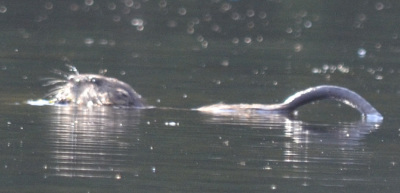
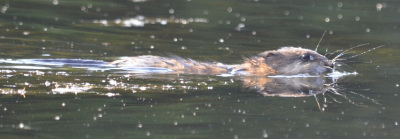
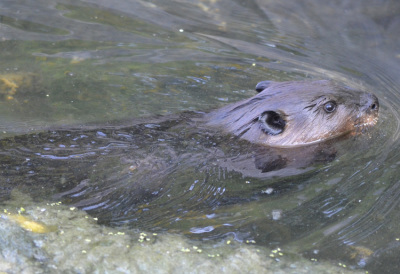
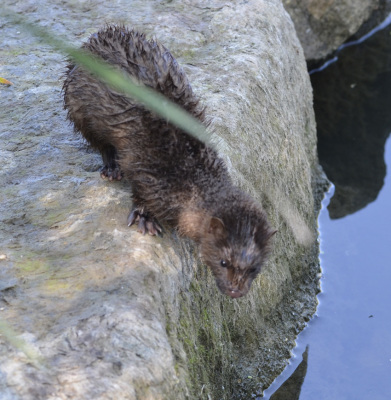
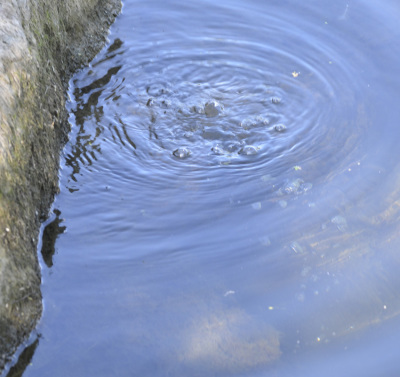
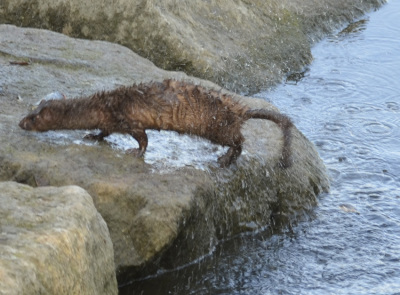
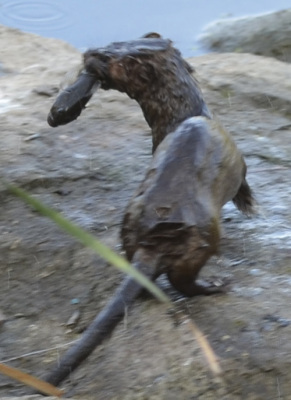
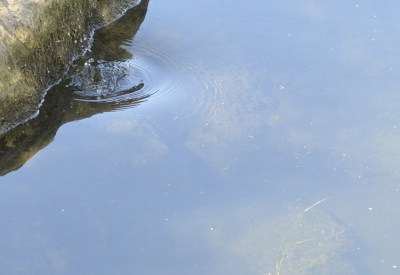
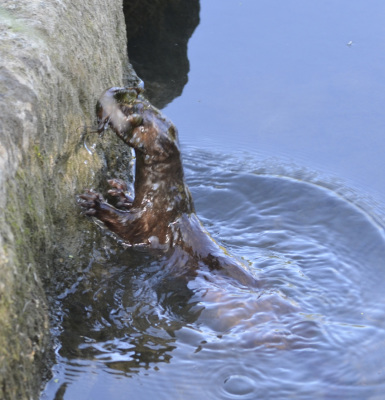
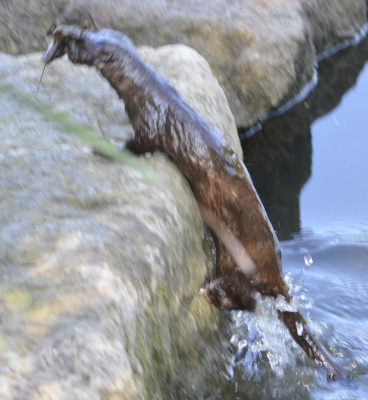
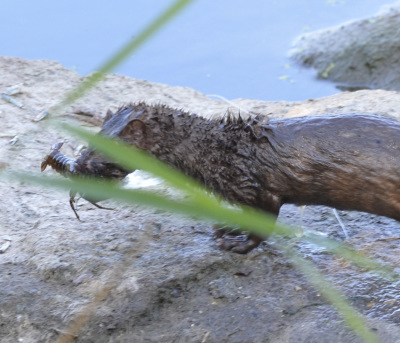
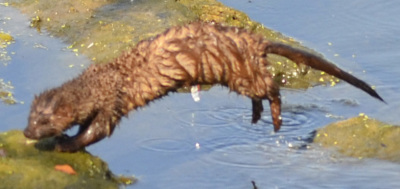
A few summers ago I was on a cottage dock in central Ontario, regrettably without camera. I was settling into my chair when something in the water caught my eye. Trying hard to locate it in the reeds, the tops of which were visibly moving – confirming this was no fish, I finally spotted a flash of brown before it disappeared under the dock. Moving as slowly as I could manage, I carefully stood up, eyes scanning all about. Silently, swiftly, effortlessly, a long, thin, dark brown body emerged from the water. It appeared to glide as it moved from the short grass at the water’s edge up onto the dock. Without hesitation it came straight towards me, ducking under my Adirondack, coming out between the chair legs only to weave between my own. In absolute silence it continued its maneuverings between the chair legs and my own, like a cat slinking around its owners legs waiting for the human to take the hint to rub its ears. Somehow it avoided actual physical contact. Three times it wove in and out, pausing between my legs before sliding back over the edge of the dock and disappearing into the long grass. I thought it might be a marten, otherwise with the amount of time underwater I would say a mink, but it was small. Any thoughts? I can tell you it was a wonderful several minutes and despite all the other wildlife, including the beavers, loons, geese and deer, it was the highlight.
Wow! What an amazing experience! I really don’t know for sure which it was. Juvenile mink can be pretty small and very bold but I have no experience with the other members of the family (Martens, weasels, etc.) Thank you for sharing though!
seen one fishing yesterday tryed to attack me after eating all the garbage fish
Interesting–I wonder if he was hoping to scare you into leaving a fish or bait behind?